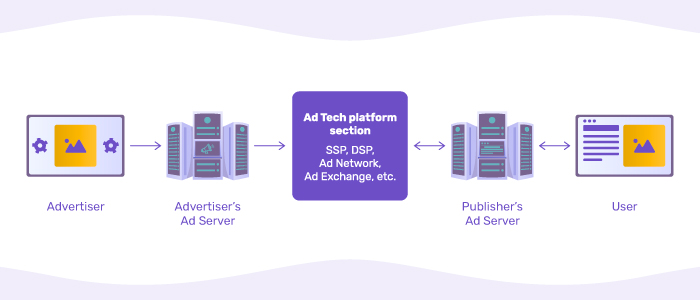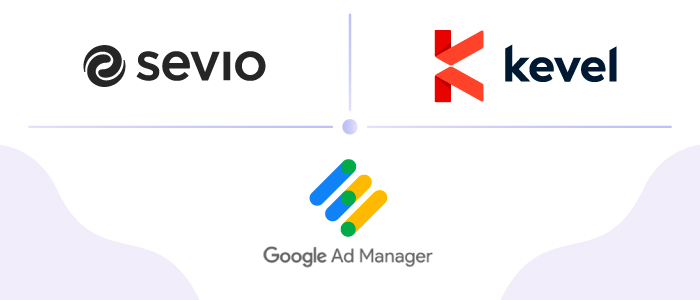How Does Ad Serving Work? A Beginner’s Guide
Let’s be honest: as marketers, we all fall into autopilot sometimes. And maybe that’s because there is something to do every time. Marketers are busy bees, constantly optimizing and analyzing, and we get so comfortable with daily tasks that the ‘how’ behind them can fade into the background.
Take PPC, for instance. Once you gain experience, it’s easy to forget the fundamental mechanics, like ad serving. Have you ever stopped to think about how exactly an ad gets delivered to the right person at the right time?
Surprisingly, many marketers with years of experience have a fuzzy understanding of this process. That’s why we’re going to break down how does ad serving work, of course, in a clear and accessible way.
What is Ad Serving?
Ad serving is the process of delivering the right ad to the right person at the right time on a website, app, or social media platform.
It’s like a complex traffic controller in online advertising, or, if you want to call it that, the central nervous system of online advertising. It’s the behind-the-scenes technology that orchestrates the connection between advertisers, publishers, and users.
In this process, advertisers set guidelines for who sees their ads (targeting) and what kind of ads they show (formats). Publishers have ad space on their websites and apps. The ad server acts like a matchmaker. It considers the advertiser’s guidelines and the publisher’s space to choose the most relevant ad for each user. It also tracks how well the ads perform and handles the billing between advertisers and publishers.
How Does Ad Serving Work?

So far, you probably pretty much get the gist of this ad serving but let’s make it a little more specific and clearer.
Ad serving is a complex process that relies on real-time communication between publishers, advertisers, and ad servers. Publishers integrate ad tags from the ad server into their platforms, specifying where ads should appear. Advertisers define their target audience and desired ad formats on advertiser platforms.
In all this process, ad servers play a key role, acting as both a matchmaker and a performance tracker. When a user visits a publisher’s site, the ad tag triggers an ad request to the publisher’s ad server. This request includes details about the user and the ad placement. The ad server then uses this information, along with publisher settings, to create an ad request object.
This object is sent to an ad exchange, a marketplace where ad inventory is bought and sold. The ad exchange then conducts a real-time bidding (RTB) auction. Eligible advertisers whose targeting criteria match the user and ad placement can submit bids through their Demand-Side Platforms (DSPs). The auction winner, typically the highest bidder or the advertiser with the most relevant ad, has their creative delivered to the publisher’s ad server.
Finally, the publisher’s ad server displays the winning ad on the webpage and tracks user interaction. This data, including impressions (ad views) and clicks, is then fed back to the advertiser’s DSP and the publisher’s ad server for campaign analysis. The entire process happens in milliseconds, ensuring a seamless user experience while delivering targeted advertising.
So, this entire laborious process represents the ad serving.
Ad Serving vs. Ad Server: Are They One And The Same Thing?
Let’s get it straightforward: ad serving and ad servers are NOT the same thing. But, yes, we can say that ad serving and ad servers are concepts that somehow work together to ensure relevant ads reach the right people at the right time. However, there’s a distinction between the two.
Ad serving refers to the entire process of delivering an ad.
Imagine you’re browsing a website. In the background, a complex procedure unfolds. Sophisticated algorithms analyze your browsing history, demographics, and past interactions to identify the most relevant ad from a vast pool. This chosen ad is then swiftly delivered to the designated space on the webpage, ensuring a smooth user experience. Finally, the ad server tracks how many times the ad is displayed (impressions), clicks received, and even if it leads to a desired action like a purchase (conversions). This data becomes crucial for advertisers to measure success and optimize their campaigns.
The ad server itself is the software platform that makes this ad-serving process possible.
It acts as a central hub for both publishers and advertisers. Publishers use ad servers to manage their ad inventory (the spaces where ads can appear), set targeting criteria to attract specific audiences and track how well the ads perform. Advertisers, on the other hand, leverage ad servers to upload their ad creatives, manage campaign budgets, and target specific demographics or interests.
In a nutshell, ad serving is the what (delivering ads), while the ad server is the how (software managing the process).
Key Components of the Ad Serving Process
Since ad serving is a whole process, it has several components working together to deliver targeted ads to users. Among the most important elements involved in the ad-serving process are:
1. Publishers – The website or app owners who have ad space on their platforms that they want to sell to advertisers. They use ad servers to manage this ad inventory (available ad space), define where ads will be placed (ad placements), and track how well the ads perform (impressions, clicks).
2. Advertisers – The businesses that want to pay to promote their products or services through online ads. They create ad campaigns specifying their target audience (who they want to reach) and design ad creatives (images, videos) to convey their message. They use advertiser platforms (Demand-Side Platforms or DSPs) to manage these campaigns.
3. Ad Servers – Software platforms that act as a central hub for the entire ad-serving process. They manage both sides of the equation:
- For Publishers (First-Party Ad Servers) – Sell-side ad servers (SSPs) help publishers manage their ad inventory, optimize ad placements for better revenue, deliver the right ads to users, and track ad performance.
- For Advertisers (Third-Party Ad Servers) – Buy-side ad servers (DSPs) are used by advertisers to manage their ad buying across ad exchanges and publisher ad networks. They help target the right audience, set budgets, and bid on ad placements.
4. Ad Exchanges and Networks – These act as marketplaces connecting publishers with advertisers:
- Ad Exchanges – These are like stock exchanges for ad inventory. They facilitate real-time auctions (RTB) where advertisers compete for ad placements on various publishers’ sites. The highest bidder or the advertiser with the most relevant ad typically wins the auction.
- Publisher Ad Networks – These platforms aggregate ad inventory from multiple publishers, allowing advertisers to reach a wider audience by buying ad space through a single platform.
For each of these components of the ad-serving process, we have separate articles for you that present what they are all about in a very easy-to-understand and comprehensive way. So, for more details about them, the following articles will help:
Top Platforms That Use Ad Serving Processes

Sevio Ad Manager
Sevio Ad Manager is a supply-side platform designed to streamline ad management for website owners (publishers). It simplifies the process of connecting with advertisers and managing ad space on websites.
The platform utilizes advanced technology to optimize ad delivery, inclusively ad-serving processes, ensuring both revenue growth and a positive user experience.
Sevio Ad Manager empowers publishers with a suite of features, including an advertiser management system for easy collaboration, flexible ad format options for customization, and a creative gallery for storing and sharing ad content. Additionally, granular audience targeting capabilities ensure ads reach the most relevant viewers, maximizing engagement.
Publishers can leverage detailed performance reports to make informed decisions and optimize their advertising strategy. The platform even allows for the creation of branded sales pages, facilitating direct ad sales without third-party involvement.
Kevel
Kevel is a customizable ad server toolkit for programmers. It lets users to quickly create a personalized ad server that is perfect for sponsored content and internal ads.
Starting at $3,000 a month, it is loved by big names like Yelp and Ticketmaster. Because of its flexibility, it is great for large or special-needs publishers. However, good coding skills are required to get the most out of it.
Google Ad Manager (formerly DoubleClick)
Google Ad Manager, previously known as DoubleClick, is a user-friendly ad management platform supported by Google’s reliable infrastructure.
It offers comprehensive tools to help publishers optimize ad inventory and revenue through automated ad placement and advanced targeting features. The platform supports various ad formats across different devices and integrates seamlessly with other Google services for improved performance analytics and reporting.
It has a simple interface, and the availability of a free version makes it an attractive solution for smaller sites looking to monetize their content effectively.
Google Ad Manager is a top choice for publishers aiming to maximize their ad revenue, whether for direct sales or programmatic advertising, due to its blend of flexibility, power, and ease of use.
Final Thoughts
So, hopefully, this article helped clear up the mystery behind how does ad serving work and how digital banners find their way to your screen! As you now know, it’s a pretty complex process, but by understanding the basic steps of how ad serving works, you’ll be better equipped to guide the advertising industry.
Moreover, now you can see the difference between the ad-serving process itself and all the other components involved, like ad servers, DSPs, and SSPs.
The important takeaway is that understanding ad serving gives you a superpower – the ability to create even better ads and target them to exactly the right people. Next time you see an ad online, take a moment to appreciate the process happening behind the scenes!